Operations | Monitoring | ITSM | DevOps | Cloud
%term
A deep, deep dive into debugging Java
This is the story of a Java debugging journey that started with a question I couldn’t answer about Java stack traces. As a long time Java programmer, I am approached for help by developers who encounter unusual problems in the language.
timeShift(GrafanaBuzz, 1w) Issue 74
Happy New Year! We hope you had a relaxing and safe holiday season, but now it’s time to get back to work! This week we share articles on the UX of Loki, visualizing pull request data from BitBucket, monitoring and observability predictions for 2019 and more! Also, we’ll be making some exciting announcements for GrafanaCon in the coming days, so stay tuned and get your ticket now!
Error Handling with Angular 6 - Tips and Best Practices
Handling errors properly is essential in building a robust application in Angular. Error handlers provide an opportunity to present friendly information to the user and collect important data for development. In today's age of advanced front-end websites, it's more important than ever to have an effective client-side solution for error handling, which is covered in this article.
Addressing the Kubernetes dashboard and external IP proxying vulnerabilities
This blog describes how Rancher and its managed kubernetes clusters can be affected by the recent announcement detailing the vulnerabilities of the proxying external IPs and dashboard.
Comparison: Node.js vs. PHP
Both Node.js and PHP are popular platforms for websites, APIs, and other types of web content. They have a few similarities, but their differences far outweigh those similarities. In this post, we’ll take a look at how they stack up against each other. It’s Node.js vs. PHP… let’s get ready for the showdown!
Serverless in 2019: From 'Hello World' to 'Hello Production'
As the CEO of Stackery, I have had a unique, inside view of serverless since we launched in 2016. I get to work alongside the world’s leading serverless experts, our customers, and our partners and learn from their discoveries. It’s a new year: the perfect time to take stock of professional progress, accomplishments, and goals.
EUC Predictions for 2019: Will It Be the Year of Digital Workspaces?
2018 was a promising year for enterprise IT in general, and specifically for End User Computing (EUC). We saw many interesting developments with the Citrix stack. 2018 marked the end of life (EOL) of the widely popular XenApp 6.5 and consequently, a majority of organizations migrated to the new Citrix Virtual Apps and Desktops version 7.
The Cost of Operational Immaturity
Digital operational maturity is defined as an organization’s effectiveness at real-time work and ability to focus on performance metrics that improve as the organization becomes more adept at responding to incidents. Based on extensive research and nine years of industry data, in conjunction with a survey of 600+ respondents from across industries, PagerDuty developed a model that identified the four following levels of operational maturity.
Network Blind Spots: Total Visibility or Not
Network blind spots study is framed within a field controlled by three well interconnected elements: monitoring, security and visibility.










